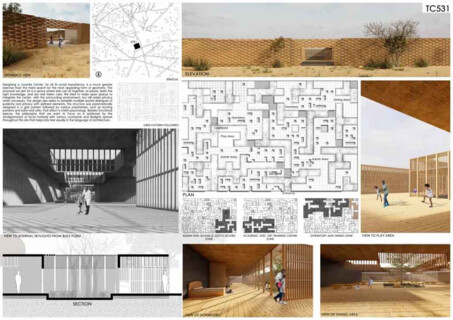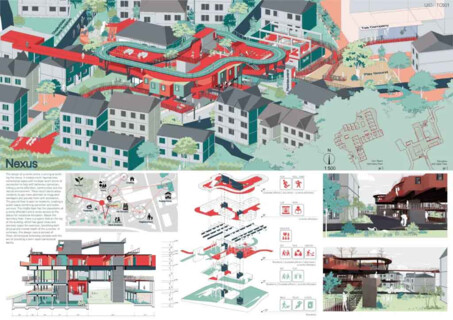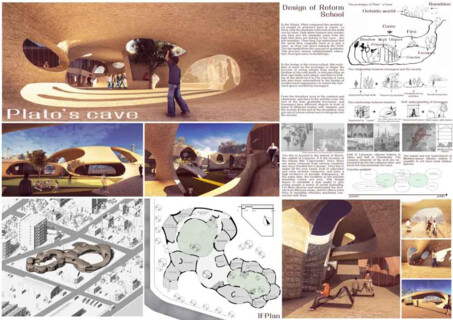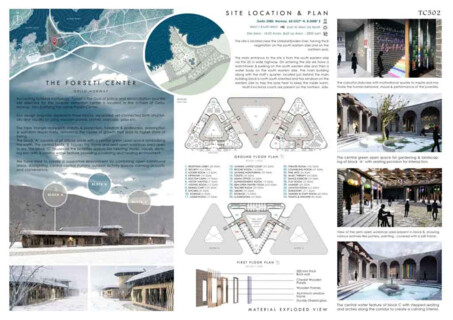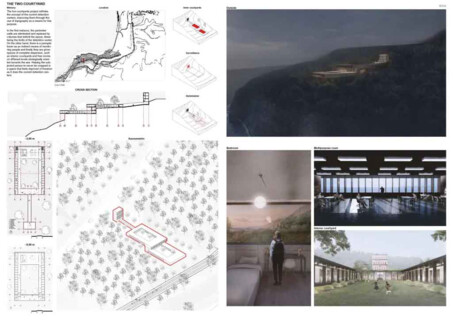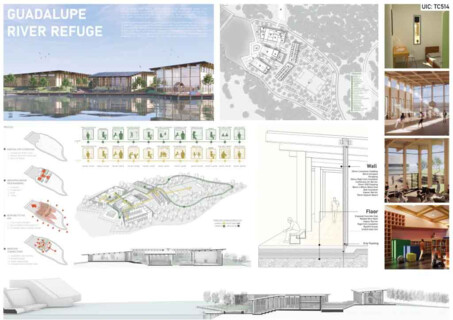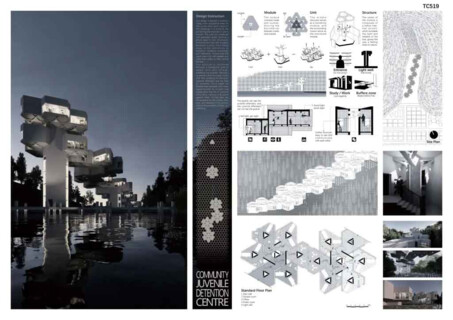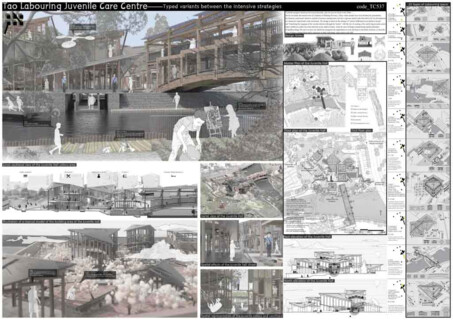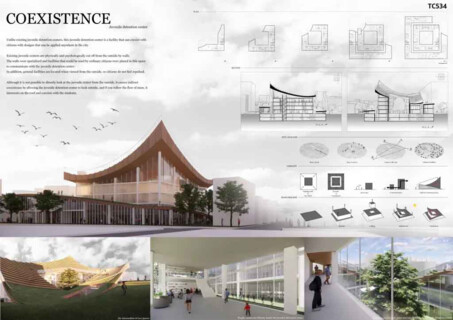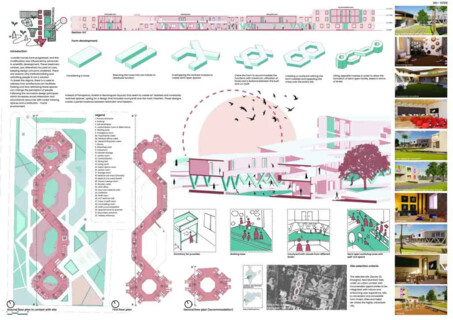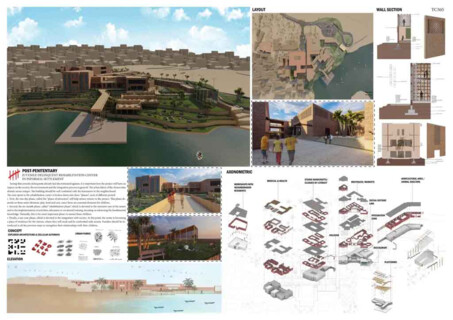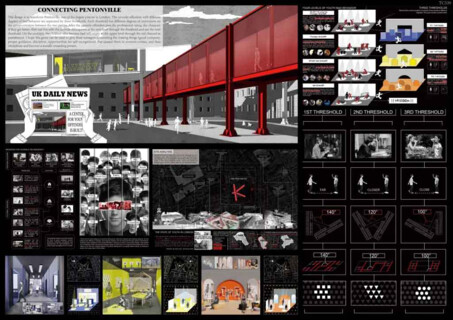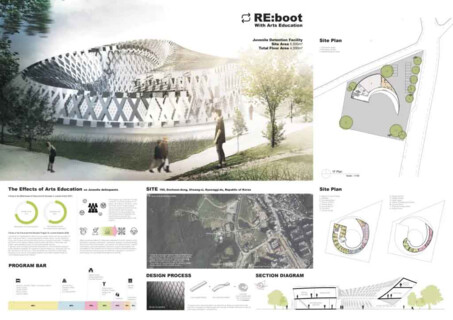- wa-ID
- wa-2034847
- Tag der Veröffentlichung
- 07.09.2022
- Aktualisiert am
- 15.12.2022
- Verfahrensart
- Offener Wettbewerb
- Zulassungsbereich
-
Andere
- Teilnehmer
- Keine Teilnahmebeschränkungen
- Auslober
- ARCH8
- Bewerbungsschluss
- 10.11.2022
- Abgabetermin
- 15.11.2022
- Bekanntgabe
- 30.11.2022
Verfahrensart
Offener Ideenwettbewerb
Wettbewerbsaufgabe
Jeden Tag werden Zehntausende von Jugendlichen in Jugendstrafanstalten inhaftiert; Tausende weitere sind in Haftanstalten und Gefängnissen für Erwachsene inhaftiert. Stellen Sie sich vor, ein kleines Kind wird für Tage, Wochen oder sogar Monate in einem winzigen, leeren Raum festgehalten. Viele Jugendstrafanstalten werden zwar als „Schulen“ bezeichnet, aber nur wenige dieser Einrichtungen bieten die Art von Unterricht, psychologischer Behandlung oder anderen Heilungsmöglichkeiten, die Kinder benötigen.
Zu viele jugendliche Straftäter werden einer Leibesvisitation, Fesseln, chemischen Sprays und 22-24 Stunden Einzelhaft pro Tag ausgesetzt. Diese missbräuchlichen Verhaltensweisen stören die normale Entwicklung und führen zu psychischen Beeinträchtigungen, emotionalen Ängsten und körperlichen Verletzungen. Zusätzlich zu dem Trauma, das durch die Isolation und die Trennung von ihren Familien, Freunden und Gemeinschaften entsteht, erleben Jugendliche im Gefängnis häufig körperliche und sexuelle Gewalt.
Das Jugendstrafsystem wurde mit dem Ziel entwickelt, Kinder zu rehabilitieren. Forschungsergebnissen zufolge ist es kontraproduktiv, Kinder über einen längeren Zeitraum einzusperren, insbesondere unter den harten Bedingungen, die im Jugendstrafvollzug nur allzu häufig anzutreffen sind, und trägt wenig zum Schutz unserer Nachbarschaft bei. Kinder haben etwas Besseres verdient.
Entwerfen Sie eine „halboffene“ Einrichtung, die Kindern Aufsicht und Struktur bietet, für 50 Kinder am Rande einer Stadt. Das Konzept sollte das Leben der Insassen und die Gesellschaft insgesamt berücksichtigen. Die Teilnehmer werden ermutigt, zu untersuchen, wie die Architektur eines Ortes das Verhalten der Menschen unter ihrem Einfluss beeinflusst.
Es gibt keine räumliche Beschränkung.
Competition assignment
Every day, tens of thousands of youngsters are detained in juvenile detention facilities; thousands more are incarcerated in adult detention facilities and jails. Imagine keeping a young child sequestered for days, weeks, or even months in a tiny empty room. While many juvenile detention centers are referred to as „schools,“ few of these establishments offer the kind of instruction, mental health treatment, or other healing services that children require.
Too many juvenile offenders are subjected to strip searches, shackles, chemical sprays, and 22–24 hours a day of solitary confinement. These abusive behaviors disrupt normal development and result in psychological impairment, emotional anguish, and physical injuries. In addition to the trauma brought on by their isolation and separation from their families, friends, and communities, youth in jail frequently experience physical and sexual violence.
The juvenile justice system was developed with the goal of rehabilitating kids. According to research, imprisoning kids for an extended amount of time, especially in the harsh conditions that are all too common in the juvenile justice system, is counterproductive and accomplishes little to safeguard our neighborhoods. Children deserve better.
Design a “semi-open” facility that gives children supervision and structure for 50 detailed children in the outskirts of a city. The concept should address the lives of inmates and society overall. Participants are encouraged to explore how the architecture of a place affects the behavior of people under its influence.
There is no area restriction.
Weitere Informationen zu den Gewinnern finden Sie unter /
More information about the winners can be found at:
arch8.in/the-callow-winners
Offener Ideenwettbewerb
Wettbewerbsaufgabe
Jeden Tag werden Zehntausende von Jugendlichen in Jugendstrafanstalten inhaftiert; Tausende weitere sind in Haftanstalten und Gefängnissen für Erwachsene inhaftiert. Stellen Sie sich vor, ein kleines Kind wird für Tage, Wochen oder sogar Monate in einem winzigen, leeren Raum festgehalten. Viele Jugendstrafanstalten werden zwar als „Schulen“ bezeichnet, aber nur wenige dieser Einrichtungen bieten die Art von Unterricht, psychologischer Behandlung oder anderen Heilungsmöglichkeiten, die Kinder benötigen.
Zu viele jugendliche Straftäter werden einer Leibesvisitation, Fesseln, chemischen Sprays und 22-24 Stunden Einzelhaft pro Tag ausgesetzt. Diese missbräuchlichen Verhaltensweisen stören die normale Entwicklung und führen zu psychischen Beeinträchtigungen, emotionalen Ängsten und körperlichen Verletzungen. Zusätzlich zu dem Trauma, das durch die Isolation und die Trennung von ihren Familien, Freunden und Gemeinschaften entsteht, erleben Jugendliche im Gefängnis häufig körperliche und sexuelle Gewalt.
Das Jugendstrafsystem wurde mit dem Ziel entwickelt, Kinder zu rehabilitieren. Forschungsergebnissen zufolge ist es kontraproduktiv, Kinder über einen längeren Zeitraum einzusperren, insbesondere unter den harten Bedingungen, die im Jugendstrafvollzug nur allzu häufig anzutreffen sind, und trägt wenig zum Schutz unserer Nachbarschaft bei. Kinder haben etwas Besseres verdient.
Entwerfen Sie eine „halboffene“ Einrichtung, die Kindern Aufsicht und Struktur bietet, für 50 Kinder am Rande einer Stadt. Das Konzept sollte das Leben der Insassen und die Gesellschaft insgesamt berücksichtigen. Die Teilnehmer werden ermutigt, zu untersuchen, wie die Architektur eines Ortes das Verhalten der Menschen unter ihrem Einfluss beeinflusst.
Es gibt keine räumliche Beschränkung.
Competition assignment
Every day, tens of thousands of youngsters are detained in juvenile detention facilities; thousands more are incarcerated in adult detention facilities and jails. Imagine keeping a young child sequestered for days, weeks, or even months in a tiny empty room. While many juvenile detention centers are referred to as „schools,“ few of these establishments offer the kind of instruction, mental health treatment, or other healing services that children require.
Too many juvenile offenders are subjected to strip searches, shackles, chemical sprays, and 22–24 hours a day of solitary confinement. These abusive behaviors disrupt normal development and result in psychological impairment, emotional anguish, and physical injuries. In addition to the trauma brought on by their isolation and separation from their families, friends, and communities, youth in jail frequently experience physical and sexual violence.
The juvenile justice system was developed with the goal of rehabilitating kids. According to research, imprisoning kids for an extended amount of time, especially in the harsh conditions that are all too common in the juvenile justice system, is counterproductive and accomplishes little to safeguard our neighborhoods. Children deserve better.
Design a “semi-open” facility that gives children supervision and structure for 50 detailed children in the outskirts of a city. The concept should address the lives of inmates and society overall. Participants are encouraged to explore how the architecture of a place affects the behavior of people under its influence.
There is no area restriction.
Weitere Informationen zu den Gewinnern finden Sie unter /
More information about the winners can be found at:
arch8.in/the-callow-winners
THE CALLOW
Every day, tens of thousands of youngsters are detained in juvenile detention facilities; thousands more are incarcerated in adult detention facilities and jails. Imagine keeping a young child sequestered for days, weeks, or even months in a tiny empty room. While many juvenile detention centers are referred to as „schools,“ few of these establishments offer the kind of instruction, mental health treatment, or other healing services that children require.
Too many juvenile offenders are subjected to strip searches, shackles, chemical sprays, and 22–24 hours a day of solitary confinement. These abusive behaviors disrupt normal development and result in psychological impairment, emotional anguish, and physical injuries. In addition to the trauma brought on by their isolation and separation from their families, friends, and communities, youth in jail frequently experience physical and sexual violence.
The juvenile justice system was developed with the goal of rehabilitating kids. According to research, imprisoning kids for an extended amount of time, especially in the harsh conditions that are all too common in the juvenile justice system, is counterproductive and accomplishes little to safeguard our neighborhoods. Children deserve better.
OBJECTIVE
Design a “semi-open” facility that gives children supervision and structure for 50 detailed children in the outskirts of a city. The concept should address the lives of inmates and society overall. Participants are encouraged to explore how the architecture of a place affects the behavior of people under its influence.
● There is no area restriction
REQUIREMENTS
● The Proposal to be presented on One Landscape Oriented A1 Sheet.
● Proposals can be presented using any technique of your choice ( Sketches, 2D Drawings, 3D Visualizations, Models, etc. )
● Team code (UIC) to be mentioned on the Top Right-Hand corner of the sheet.
● The proposal MUST NOT include any information (name, Organization, School, etc.) that may give away your identity.
● All text must be in ENGLISH, with a maximum of 150 words for project explanation.
● All dimensions should be imperial or metric units.
REGISTRATION DETAILS
Early-bird Registration: 8th SEP - 30th SEP’22
Indian National: 450 INR
Foreign National: 10 USD
Standard Registration: 1st OCT - 20th OCT’22
Indian National: 520 INR
Foreign National: 13 USD
Late Registration: 21st OCT - 10th NOV’22
Indian National: 750 INR
Foreign National: 20 USD
NOTE:
A team can have up to 3 members.
The amount is non-refundable.
Late registered participants will receive 10 extra days for submission.
ELIGIBILITY CRITERIA
Anyone can participate irrespective of profession or qualification, and present their ideas. Participants can submit multiple entries but that would require multiple registrations.
A team can have up to 3 members.
TIMELINE
Registration deadline: 10th NOVEMBER 2022
Submission deadline: 15th NOVEMBER 2022
The submission deadline for all the participants who registered from 21st October to 10th November is 25th NOVEMBER 2022
Result announcement: 30th NOVEMBER 2022
*All the Deadlines are 23:59 IST (INDIA)
The following dates can be a subject of modification, if necessary.
SUBMISSION FORMAT
Submit in .jpeg format of file size not more than 5Mb.
Submit your entry at: submissions@arch8.in
The subject of the mail: Your UIC (XXXXX)
Name of the file uploaded: Your UIC (XXXXX)
PRIZES
Total cash prize worth 21,000 INR.
Winner: Cash prize of INR 10000 + Acknowledgement on our website and social media + publication of the participants’ interview (Video) on website + 40% discount on your next architecture competition + certificate of achievement
1st Runner-up: Cash prize of INR 6500 + Acknowledgement on our website + publication of the participants’ interview (Video) on website + 30% discount on our next architecture competition + certificate of achievement
2nd Runner-up: Cash prize of INR 4500 + Acknowledgement on our website + publication of the participants’ interview (Video) on website + 20% discount on our next architecture competition + certificate of achievement
10 Honorable mentions: Acknowledgement on our website + 10% discount on our next architecture competition + certificate of achievement
Participation certificate for all the participants.
EVALUATION CRITERIA
Entries will be evaluated based on the following criteria:
1. ORIGINALITY
2. CREATIVITY
3. INNOVATION
4. PRESENTATION
FAQs
1. What is the nature of the competition?
‚THE CALLOW’ is an open idea design competition challenge that is open for students, professionals & any individual with a creative mind.
2. Who can participate in the competition?
Architecture students, Architects, Interior Designer, Civil engineers & anyone with creativity can participate in the competition.
3. How many members can be a part of a team?
A team can have a maximum of 3 members. You can also participate individually.
4. Will every participant get a certificate of participation?
Yes, each registered participant will receive an e-certificate.
5. What should be done in case a payment mode is not available in a particular country?
In such a case, we request the participants to write about the issue at hello@arch8.in to get other payment options. We will send all possible payment methods.
6. How will a team get its Unique Identification Code?
The Unique Identification Code ( UIC ) will be mailed to your registered e-mail address within 24 hrs after completing the registration process. There is only one UIC code for all the team members of a team.
7. What is the use of a Unique Identification Code?
All the participants are requested to use their UIC at the top right corner of their submission as it is your identity for the competition-related processes.
8. What to do if a participant does not receive the UIC after making payment?
In such cases, the participants are asked to mail their payment receipt hello@arch8.in. ;
9. Does the 150-word limit include legends & one-liners in the sheet?
No, the 150-word limit is for the proposal explanation only and it does not include the legends & one-liners on the sheet.
RULES AND REGULATIONS
1. In case you still have questions related to the briefs and the competition, please send them to hello@arch8.in
2. It is possible to amend or update any information relating to your registration including the names of team members once registered, mail us your query at hello@arch8.in.
3. Participant teams will be disqualified if any of the competition rules or submission requirements are not considered.
4. Team code (UIC) is the only means of identification of a team as it is an anonymous competition. Hence, a submission with its UIC will be disqualified from the competition.
5. The official language of the competition is English.
6. The registration fee is non-refundable.

